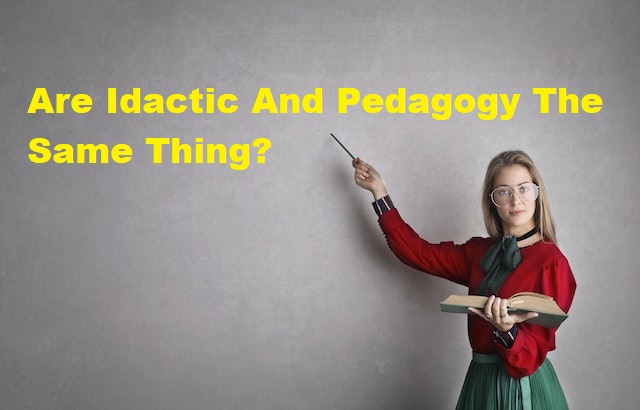Idactic is one of the two main teaching philosophies and is an organized, teacher-focused approach with an emphasis on teachers instructing pupils.
Knowing what idiomatic teaching is and how it differs from pedagogy will help teachers employ better teaching strategies for both themselves and their students.
But in this article, we define idactic teaching, discuss idactic teaching strategies, and outline the key distinctions between idactic and pedagogy.
What Is Idactic Teaching?
Idactic teaching is a type of instruction that concentrates on teachers instructing students. Teachers who employ this kind of instruction frequently design lectures-heavy, planned lessons. Depending on the needs of their pupils, their own preferences, and other circumstances, teachers might utilize a variety of teaching techniques. Idactic instruction is frequently effective for instructing pupils who learn best when given clear instructions and for teaching fundamental concepts.
What Is The Idactic Method Of Instruction?
The idactic teaching method entails a teacher giving a pupil direct instruction through prepared lessons and lectures. Idactic instruction is distinguished by:
Structured Lesson Plan:
Lesson plans that are well-structured are one of Idactic teaching’s top attributes. Idactic teachers maintain a well-organized lesson plan so they may offer material to their pupils immediately.
Specific Learning Objectives:
Specific learning objectives are typically set for pupils by teachers who employ the idactic teaching method. To assist their pupils in achieving these goals, they create lesson plans and offer homework.
Periodic Performance Reviews:
As part of the Idactic teaching methodology, teachers also carry out periodic performance reviews to determine how well their students are doing in terms of meeting their learning objectives. Performance reviews can help teachers gauge how well their pupils are grasping the material.
Lectures From The Teacher To The Student:
Idactic teaching also places a strong emphasis on lectures given by the teacher to the pupil. Take notes during lectures and ask questions to learn more.
Group Discussions:
Group conversations are a common component of the Idactic teaching method after a lecture or reading. By posing open-ended questions in the lesson and promoting critical thinking in their students, teachers can direct dialogues.
Consistent Learning Schedules:
Consistent learning schedules are yet another essential component of the Idactic teaching strategy. Idactic teaching methods typically involve classroom schedules that don’t vary many days today.
Advantages & Disadvantages Of Idactic Material:
Advantages:
- Real language is presented to the students.
- Most of them have accurate information that can be acquired.
- There is no erroneous language in textbooks.
- Some pupils might get inspiration from real-world resources.
- One text can be utilized for many different tasks and activities.
- In real writing, a variety of styles, genres, and formalities are available.
- They may inspire students to read books for enjoyment.
Disadvantages:
- Due to cultural differences, understanding authentic literature may take time and effort.
- The students might not require the vocabulary as a whole.
- For novices, they are fairly challenging.
- It can be difficult and time-consuming to prepare texts and exercises.
- Listening reveals a wide range of accents and dialects.
- The information quickly becomes dated (news).
Importance Of The Use Of Idactic Materials:
- Help in the environment and learning process.
- Promote learning.
- Encourage children’s imagination and capacity for abstract thought.
- Save time on the selection, creation, and delivery of the explanations.
- expand your vocabulary.
- To aid in the learning process, encourage the development of many intelligences, such as logical, systemic, lateral, creative, and critical thinking.
- Help in memory and learning.
What Is The Difference Between Idactic And Pedagogy?
The two primary teaching techniques are idactic and pedagogy. Although idactical methods can be included in pedagogical approaches, there are significant contrasts between the two ways of teaching. Idactic and pedagogy differ significantly in a number of ways, including:
Teacher-Centered Vs. Learner-Centered:
The emphasis placed on the teacher or the student distinguishes idactics from pedagogy, for example. Idactics is frequently teacher-focused. For instance, a typical idactical technique is a teacher giving a lecture to their students. However, learner-centered pedagogy entails developing instructional strategies that concentrate on the various learning styles of particular pupils.
What Vs. Why:
Idactic and pedagogy, however, vary in another way. While pedagogy considers why to educate students, idactic tends to focus more on how to educate students. As a result, educators who employ pedagogical methods frequently highlight the theories and methods that inform their instruction.
Content Vs Methods:
Idadctic and pedagogy differ depending on whether they prioritize teaching methods or curricular content. The pedagogical teaching method places more emphasis on how teachers might use various tools and strategies to teach their pupils, whereas the idactic teaching approach typically places more emphasis on the curriculum’s content.
Process-Oriented Vs. Knowledge-Oriented:
The fact that pedagogy is process-oriented while idactics is knowledge-oriented is another significant distinction between the two learning strategies. Direct knowledge transfer to students is a primary goal of idactically oriented teachers. However, pedagogical approach teachers place more of an emphasis on the process and art of teaching.
Teaching Approaches Of Idactical And Pedagogical Theory:
Both idactical and pedagogical teachers employ a variety of distinct instructional strategies. There are several fundamental idactical teaching strategies that can be used, though.
Demonstration:
The demonstration is a method of teaching whereby the instructor exemplifies an idea. When used in conjunction with visual elements like writing on a whiteboard, the presentation approach can be particularly powerful.
Explanation:
Explaining a topic to students is a teaching approach that can be used alone or in conjunction with demonstration to improve learning.
Observation:
Students use the statement method to make statements in order to learn more about issues. To better comprehend a concept, students might watch their teacher demonstrate it.
Problems:
To help pupils learn their curriculum, teachers might develop problems for them to solve. Students can learn math skills and other topics by working through challenges.
Exercises:
By giving their pupils exercises to perform, teachers can assist their students in gaining new knowledge and skills. Exercises, like problems, give students the chance to put concepts into practice and improve their knowledge.
Several particular educational teaching techniques include:
Collaboration In The Classroom:
Promoting communication and teamwork among students is part of the classroom collaboration teaching technique. Teachers frequently assign students to small groups to promote collaboration.
Hands-On Learning:
This method places a focus on learning new skills by actually practicing them. For students that learn kinesthetically, hands-on learning can be very successful and can be paired with books and lectures.
Classroom Technology:
Classroom technology is used by many instructors who follow the pedagogical method. Tablets, computers, and other gadgets may be used in the classroom. Technology in the classroom can help teachers engage their pupils more fully.
Visualization:
Visualization is a teaching approach that allows students to picture the abstract ideas they are learning about through activities like field excursions and experiments.
Modeling:
The modeling strategy, like the demonstration strategy, involves a teacher showing a concept and students learning by observing and practicing. Teachers can combine the modeling strategy with other strategies, including hands-on learning and classroom collaboration.
Conclusion:
Idactics is one of the two main teaching philosophies and is an organized, teacher-centered approach that focuses on the instruction of students by teachers. After reading this post, we hope you understood everything, from the meaning of Idactic to the requirements, teaching methods, and differences between idactic and pedagogy.


